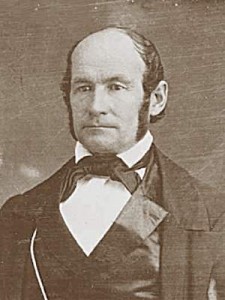Heber C. Kimball was influential in the early days of The Church of Jesus Christ of Latter-day Saints or LDS Church. He was one of the original twelve apostles called by the Prophet Joseph Smith, and served as the Prophet Brigham Young’s counselor. Heber C. Kimball was born on June 14, 1801, in Sheldon, Vermont. He was born into a good, upstanding family that taught him from the Bible. His parents, however, were not affiliated with any church. From the time he was twelve years old, he said he thought often about how to gain a knowledge of salvation. When he could find no one who he felt could teach him the truth about God, he decided not to espouse any particular church, but did his best to live a moral life. This was an endeavor that Heber continued throughout his life. He became a freemason, which meant that he vowed not to drink or do anything immoral.Kimball was a blacksmith by trade, having been taught in the trade since the time he was fourteen. He set up a blacksmith shop, and when he was 21, met and married Vilate Murray. They were married on November 7, 1822. In 1831, Kimball and one of his good friends, Brigham Young, heard that five men from the Mormon Church were in the area and were going to preach a sermon. The men were curious and attended the meeting. It was here that he heard about the gospel for the first time. A short time later, on April 16, 1832, Heber was baptized and confirmed a member of the LDS Church. Brigham Young was also baptized and later became the second Prophet of the Church. Kimball’s wife was baptized two weeks later. In late October of the same year, he moved his family to Kirtland, Ohio, which was then the headquarters and gathering place of the LDS Church.
 In 1834, Kimball joined Joseph Smith and many others in Zion’s Camp, a group of men whose goal was to help the members who were being persecuted in Missouri. During this time, Kimball was one of the twenty men who were chosen to be the Prophet Joseph Smith’s guard.
In 1834, Kimball joined Joseph Smith and many others in Zion’s Camp, a group of men whose goal was to help the members who were being persecuted in Missouri. During this time, Kimball was one of the twenty men who were chosen to be the Prophet Joseph Smith’s guard.
Heber C. Kimball was called to be an apostle for the LDS Church on February 14, 1835, and in May of the same year went on his first Mormon mission to the Eastern United States and Canada. In May of 1836, he was called to go on another Mormon mission, this time alone, and he baptized thirty people. These first missions prepared Heber C. Kimball for what would be asked of him next. On Sunday, June 4, 1837, the Prophet Joseph Smith, “came to me [Kimball], while I was seated in front of the stand, above the sacrament table, on the Melchizedek side of the Temple, in Kirtland, and whispering to me, said, ‘Brother Heber, the spirit of the Lord has whispered to me; “Let my servant Heber go to England and proclaim my gospel, and open the door of salvation to that nation”‘” (From Heber C. Kimball’s journal).
Kimball accepted this assignment, and Orson Hyde, Willard Richards, and Joseph Fielding were called to go and help him with the mission. When they arrived in England, the first converts joined the LDS Church in Preston. On Sunday, August 6, 1837, the first branch outside of the United States, made up of 28 new converts, was created. The LDS Church in the area grew quickly, and by October 1837, it was necessary to divide the branch in Preston into five branches. By the end of his eight month mission, Kimball had personally baptized 1,500 people. Kimball served another mission in 1840 to England that had as much success as the first.
In 1844 Joseph Smith was murdered, and the Saints were being pushed out of Illinois. Kimball helped Brigham Young come up with a plan for the Saints’ exodus to Utah. In 1847 Kimball was called to the First Presidency of the Church with Brigham Young as the President. Kimball led a large party of Mormon Saints across the plains in 1848, and finally established his family in Utah. He continued to fulfill his duties with the Church and to oversee the mission in England until he passed away on June 22, 1868.